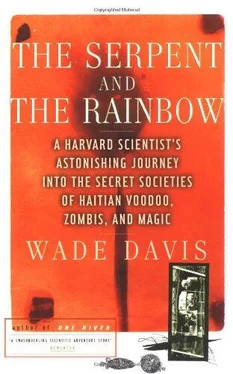Wade Davis - The Serpent and the Rainbow
Здесь есть возможность читать онлайн «Wade Davis - The Serpent and the Rainbow» весь текст электронной книги совершенно бесплатно (целиком полную версию без сокращений). В некоторых случаях можно слушать аудио, скачать через торрент в формате fb2 и присутствует краткое содержание. Год выпуска: 1985, Издательство: Simon & Schuster, Жанр: Старинная литература, на английском языке. Описание произведения, (предисловие) а так же отзывы посетителей доступны на портале библиотеки ЛибКат.
- Название:The Serpent and the Rainbow
- Автор:
- Издательство:Simon & Schuster
- Жанр:
- Год:1985
- ISBN:нет данных
- Рейтинг книги:5 / 5. Голосов: 1
-
Избранное:Добавить в избранное
- Отзывы:
-
Ваша оценка:
- 100
- 1
- 2
- 3
- 4
- 5
The Serpent and the Rainbow: краткое содержание, описание и аннотация
Предлагаем к чтению аннотацию, описание, краткое содержание или предисловие (зависит от того, что написал сам автор книги «The Serpent and the Rainbow»). Если вы не нашли необходимую информацию о книге — напишите в комментариях, мы постараемся отыскать её.
The Serpent and the Rainbow — читать онлайн бесплатно полную книгу (весь текст) целиком
Ниже представлен текст книги, разбитый по страницам. Система сохранения места последней прочитанной страницы, позволяет с удобством читать онлайн бесплатно книгу «The Serpent and the Rainbow», без необходимости каждый раз заново искать на чём Вы остановились. Поставьте закладку, и сможете в любой момент перейти на страницу, на которой закончили чтение.
Интервал:
Закладка:
Today the Japanese passion for puffers is something of a national institution. In Tokyo alone puffers are sold by over eighteen hundred fish dealers. Virtually all the best restaurants offer it, and to retain some semblance of control the government actually licenses the specially trained chefs who alone are permitted to prepare it. Generally the meat is eaten as sashimi. Thus sliced raw, the flesh is relatively safe. So are the testes, except that they are sometimes confused with the deadly ovaries by even the most experienced chefs. Yet many connoisseurs prefer a dish known as chiri , partially cooked fillets taken from a kettle containing toxic livers, skins, and intestines. Lovers of chiri are invariably among the hundred or more fatalities that occur each year.
The Japanese prefer and pay premium prices for four species of puffer, all in the genus Fugu , and all known to be violently poisonous. Why would anyone play Russian roulette with such a creature? The answer, of course, is that fugu is one of the few substances that walks the line between food and drug. For the Japanese, consuming fugu is the ultimate aesthetic experience. The refined task of the fugu chef is not to eliminate the toxin, it is to reduce its concentration while assuring that the guest still enjoys the exhilarating physiological aftereffects. These include a mild numbing or tingling of the tongue and lips, sensations of warmth, a flushing of the skin, and a general feeling of euphoria. As in the case of so many stimulants, there are those who can’t get enough of a good thing. Though it is expressly prohibited by law, certain chefs prepare for zealous clients a special dish of the particularly toxic livers. The organ is boiled and mashed and boiled again and again until much of the toxin is removed. Unfortunately, many of these chefs succumb to their own cooking. It was such a dish that caused the controversial death in 1975 of Mitsugora Bando VIII, one of Japan’s most talented Kabuki actors, indeed, an artist who had been declared a living national treasure by the Japanese government. He, apparently, like all of those who eat the cooked livers, was among those who, in the words of one fugu specialist, enjoy “living dangerously.”
Because of its popularity as a food and the relatively high incidence of accidental poisonings, the fugu fish has generated an enormous medical and biomedical literature. Exploring that literature for clinical descriptions and case histories, I was immediately struck by the parallels to the zombi phenomenon. In describing his experience to me Clairvius Narcisse recalled remaining conscious at all times, and although completely immobilized could hear his sister’s weeping as he was pronounced dead. Both at and after his burial his overall sensation was that of floating above the grave. He remembered as well that his earliest sign of discomfort before entering the hospital was difficulty in breathing. His sister recalled that his lips had turned blue, or cyanotic. Although he did not know how long he had remained in the grave before the zombi makers came to release him, other informants insist that a zombi may be raised up to seventy-two hours after the burial. The onset of the poison itself was described by several houngan as the feeling in victims “of insects crawling beneath your skin.” Another houngan offered a poison that would cause the skin to peel off the victim. Popular accounts of zombis claim that even female zombis speak with deep husky voices, and that all zombis are glassy-eyed. Several houngan suggested that the belly of the victim swells up after he or she has been poisoned.
Once again, recall the list of medical symptoms from the right-hand side of my blackboard. At the time of his reputed death Narcisse suffered digestive troubles with vomiting, pronounced respiratory difficulties, pulmonary edema, uremia, hypothermia, rapid loss of weight, and hypertension. Note that these symptoms are quite specific and certainly peculiar.
Now compare Narcisse’s constellation of symptoms with the following specific description of the effects of tetrodotoxin [italics mine]:
The onset and types of symptoms in puffer poisoning vary greatly depending on the person and the amount of poison ingested. However, symptoms of malaise , pallor, dizziness, paresthesias of the lips and tongue and ataxia develop. The paresthesias which the victim usually describes as a tingling or prickling sensation may subsequently involve the fingers and toes, then spread to other portions of the extremities and gradually develop into severe numbness. In some cases the numbness may involve the entire body, in which instances the patients have stated that it felt as though their bodies were floating . Hypersalivation, profuse sweating, extreme weakness, headache, subnormal temperatures , decreased blood pressure, and a rapid weak pulse usually appear early. Gastrointestinal symptoms of nausea, vomiting, diarrhea and epigastric pain are sometimes present. Apparently the pupils are constricted during the initial stage and later become dilated. As the disease progresses the eyes become fixed and the pupillary and corneal reflexes are lost…. Shortly after the development of paresthesias, respiratory distress becomes very pronounced and … the lips, extremities and body become intensely cyanotic . Muscular twitching becomes progressively worse and finally terminates in extensive paralysis . The first areas to become paralyzed are usually the throat and larynx, resulting in aphonia, dysphagia , and complete aphagia. The muscles of the extremities become completely paralyzed and the patient is unable to move . As the end approaches the eyes of the victim become glassy. The victim may become comatose but in most cases retains consciousness, and the mental faculties remain acute until shortly before death . [See Halstead, Annotated Bibliography.]
Several physicians report this most peculiar state of profound paralysis, during which time most other mental faculties remain normal. One notes “the patient’s comprehension is not impaired even in serious cases. When asked about his experiences he can describe everything in detail after recovery.” Other documented and pronounced symptoms of tetrodotoxin poisoning include pulmonary edema, hypotension, cyanosis, hypothermia, nausea and vomiting. Respiratory distress is almost always the first symptom of the poisoning, and many victims develop distended bellies. The third day after exposure to tetrodotoxins, large skin blisters may appear; by the ninth day the skin begins to peel off. A Chinese patient admitted to the Queen’s Hospital in Honolulu complained that he felt “numb from neck to toes with a feeling of ants crawling over him and biting him.”
This list is not exhaustive. In all, Narcisse shared twenty-one or virtually all the prominent symptoms documented in known cases of tetrodotoxin poisoning.
Not only did the individual symptoms of zombification and tetrodotoxication sound remarkably similar, but entire case histories from the Japanese literature read like accounts of the living dead. A Japanese peddler shared a dish of chiri with several mates and suffered all the classic symptoms of puffer poisoning. The physicians gave up, certain that the man was dead, but the individual recovered, and not fourteen hours after he had eaten the poisonous food he walked out of the hospital. A Korean miner and his son ate the ovaries of a species of Sphoeroides and within an hour were taken to the hospital. The father retained “clear consciousness” until he died; his son suffered complete immobility for about two hours but recovered naturally without treatment.
These two accounts illustrate one of the most eerie characteristics of puffer poisoning. Tetrodotoxin induces a state of profound paralysis, marked by complete immobility during which time the border between life and death is not at all certain, even to trained physicians. I need hardly express the significance of this in terms of the zombi investigation. It became quite clear that tetrodotoxin was capable of pharmacologically inducing a physical state that might actually allow an individual to be buried alive.
Читать дальшеИнтервал:
Закладка:
Похожие книги на «The Serpent and the Rainbow»
Представляем Вашему вниманию похожие книги на «The Serpent and the Rainbow» списком для выбора. Мы отобрали схожую по названию и смыслу литературу в надежде предоставить читателям больше вариантов отыскать новые, интересные, ещё непрочитанные произведения.
Обсуждение, отзывы о книге «The Serpent and the Rainbow» и просто собственные мнения читателей. Оставьте ваши комментарии, напишите, что Вы думаете о произведении, его смысле или главных героях. Укажите что конкретно понравилось, а что нет, и почему Вы так считаете.












